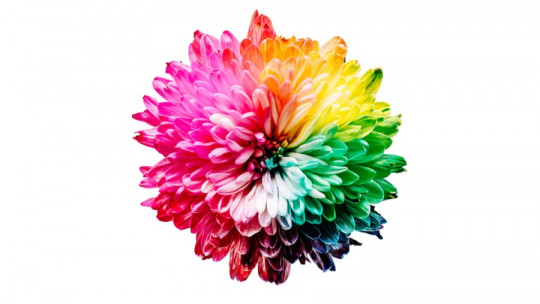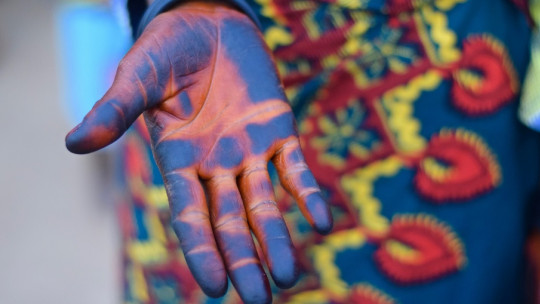
We are in the middle of nature, on a closed night and with storm clouds blocking the light of the Moon and the stars. The darkness and blackness make it difficult to see, something broken only by the light of lightning. We don’t know what’s around us, if something or someone is lurking there or even if we’re about to fall off a cliff.
In this context, something common throughout the history of humanity, blackness is obviously something fearful and distressing. And the truth is that the color associated with the absence of light, black (despite the fact that in nature it is practically impossible to find total darkness), has carried this conception throughout history and has acquired a certain symbolism that lasts. Even today, it can cause different effects on our psyche. and our behavior (something that has in fact been observed by psychology as well as other sciences and even arts). What does the meaning of black mean in psychology? Let’s see it throughout this article.
The absence of light
Before starting to evaluate what the color black implies, it is first necessary to evaluate what this color is. In general, the perception of color is produced by the arrival of certain wavelengths of light to the eye, which are produced when objects absorb part of the light and reflect the rest in such a way that it can reach our eyes. That is to say, the colors come from and are in fact the product of our eyes capturing light.
In the case of black, this is not the case. Traditionally black has been considered the total absence of color, as opposed to white which would imply the mixture of all colors. But in reality, more than the absence of color (after all, we do not stop perceiving it, and also at the level of pigment in the background, the mixture of all the colors would give black), we should talk about the absence of light. And this is because at a visual level, if we see a black color it is because the object in question (or the dye that impregnates it) absorbs all the wavelengths of the light that reaches it, and therefore cannot be reflected on our retina.
In the same way we see this color in total darkness, and for identical reasons: black is the product of the absence of light reaching our eyes. In short, we could say that the perception of blackness is, in reality, non-perception. But the truth is that it is complex that no type of light is reflected at all, something that allows us to detect different types of black.
What does the color black mean?
As with the rest of the colors, Black has acquired a symbolic and psychological meaning over time (in turn influenced by symbolism) depending on those elements that have been associated with said color. Specifically, the most obvious connection of black is with darkness and night, that is, the absence of light. And in this sense, a series of links, mostly negative, have been granted. In fact, this is probably the color that has received the worst consideration, its union with others being the reason that its symbolism turns towards the negative.
In this sense, we link black with the unknown, the terrifying, the dark and even the evil. It is a color associated with what scares us and what we cannot see (something logical considering that in the absence of light the only thing visible is blackness). This also means that it is associated with aspects that are also unknown to us and scare us, death being the best known (It is one of the colors most associated with mourning, although not the only one). It is also related to loneliness, suffering, sadness and longing.
Also with cruelty, lies, manipulation, betrayal and concealment. It is considered denial, the antithesis of the visible (for example, if light red represents energy and passion, its association with black is usually linked to violence and excess) and danger. Furthermore also It has been linked to individualism and introversion.
On the other hand, although traditionally the negative aspects with which it is related are usually valued above all, the truth is that black also has more neutral or even positive connotations. It is the color of mystery (which does not always have to be negative), seriousness and elegance, as well as nobility. Perhaps because of its connection with death, it is also usually linked with strength and power, with the absolute and with dominance and autonomy. Also of rebellion against the established. And even though it may seem strange, sometimes even with peace and the end of pain. It is also a symbol of simplicity, order and inner life.
Psychologically, black tends to generate a feeling of doubt and mystery, and can generate both fear and curiosity. He is associated, according to Eva Heller, with youth and impartiality. In addition to that generates a feeling of elegance, usually suggesting security and strength, as well as distinctiveness. Its practical use usually leads others to appreciate greater reliability and even attractiveness. It also usually gives the impression of sobriety and formality. But it can also cause feelings of intimidation, distance and arrogance if it occurs in excess. It also usually generates a feeling of protection for the user and attenuation of the emotional, even the restriction and inhibition of its expression.
The use of black in everyday life
Although it has traditionally been a frowned upon color, black is used in a large number of areas and contexts.
Probably one of the contexts in which the use of black is best known is in funerals, being one of the most widespread mourning colors in Western society. However, black is appropriate for a large number of celebrations, some much more joyful. For example, it is the color that bride and groom usually wear at weddings, due to its connection with force, security and formality.
Beyond specific social events, black is usually used since it is stylish and can be easily combined with almost any color. Its use is common in people who do not like to attract attention. In some cases, it can also be used to give the impression of being mysterious or rebellious. In addition, it is a color that tends to absorb heat, something to avoid in already hot environments or to look for in colder ones.
It is a color that is also useful in the workplace, giving a feeling of seriousness and professionalism in job interviews. In many jobs it is usually a common color due to the aforementioned relationship with seriousness and impartiality, as in the case of judges.
Regarding its use in homes and inside buildings, it usually gives rise to an impression of masculinity and sophistication. Despite this, it is not advisable to paint a room completely black, since it will give a feeling of constriction and smallness and will probably be linked to depressive-type psychological states. As for business meetings, its connection with concealment means that it is not entirely appropriate beyond specific elements.
However, the use of black decorations and elements as contrast will generate the feeling of sobriety mentioned above. As with clothing, the fact that it absorbs heat can also be valuable.
At the level of marketing and advertising, it is usually used in brands that aim to generate a vision of elegance and exclusivity, strength and purity. It is generally linked to luxury, along with gold.
The color black in different cultures
The meaning of black is generally what we have talked about previously, but it is necessary to take into account that different cultures have a different relationship with said color.
Specifically, in desert places black is usually linked to rain, with storm clouds being that color. In ancient Egypt it was a symbol of growth and fertility. Currently, African tribes such as the Masai also often relate black with life and prosperity, because it is usually associated with rain.
Other cultures such as the Japanese link it with femininity, as well as with mystery. In ancient China he was considered the king of colors. These cultures often link black with the element of water, as well as with childhood. This color is thought to give us spiritual strength, linking with the energy known as chi. He was also considered beautiful, to the point that in the past it was considered beautiful to dye your teeth that color.
Regarding religions, Christianity was often identified with evil, death and pain, although also the rejection of material things. Also in the case of Judaism it has been associated with death and unhappiness, and In the case of Islam it is associated with pain and sadness (Although the Kaaba of Mecca is black, it is thought that it was originally white but was stained by the sin of men). In India it is also associated with nothingness and evil, although despite this it is used as protection against it: the goddess Kali has a complexion of this color, being the goddess who fights against evil.








